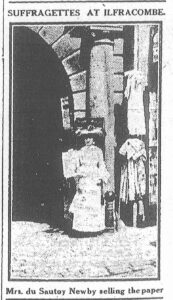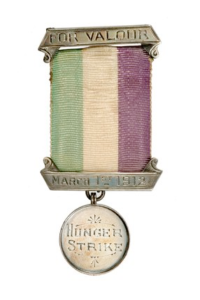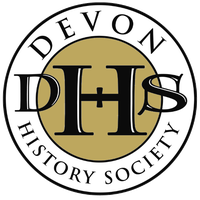Newby, Mrs Kathleen Marie Anstice du Sautoy, St Mary’s, 14 Broad Park Avenue, Ilfracombe
Kathleen Marie Anstice du Sautoy (1880 – 1962) was born in Bromley, Kent. Shortly afterwards her father, Frederick du Sautoy, a clergyman, moved the family to Penzance. She married in 1902 to Charles Henry Newby, FRCS, LRCP, (1849-1928) a respected surgeon then living in Portsmouth. By the time their daughter, also Kathleen Marie (1905-1931) was born they were living at St Mary’s, 14 Broad Park Avenue, Ilfracombe. It was in this North Devon town that she became a pivotal figure in galvanising local support for the militant Suffragette movement.
The first recorded mention of Marie Newby’s involvement with the movement was in November 1910. Annie Kenney spoke at the Runnacleave Theatre, Ilfracombe, on Thursday September 8[1] and returned in the autumn to capitalise on interest there with the formation of a Women’s Social and Political Union (WSPU) group. ‘Mrs Newby kindly lent her drawing room on Thursday last to give Miss Kenney the opportunity of meeting Ilfracombe and Barnstaple members. A good number turned up and the new branch promises to be most active. It was decided to hold a meeting on Saturday November 12 when Lady Isabel Margesson will speak.’ Marie Newby was elected the Hon. Secretary and hosted regular meetings of the fledgling group at her home.[2] Together with Nurse Anne Ball she gathered a growing band of supporters around her, who, over the next few years, enthusiastically embraced the WSPU’s call to action. They set their inhibitions aside and took to the streets to demand Votes for Women, a step that took enormous courage. Marie Newby campaigned wearing an apron advertising Votes for Women. It was unthinkable that a lady of her standing and position within the town should protest on street corners; she would have been shunned by friends and neighbours for whom this degrading activity was a step too far.[3]
took to the streets to demand Votes for Women, a step that took enormous courage. Marie Newby campaigned wearing an apron advertising Votes for Women. It was unthinkable that a lady of her standing and position within the town should protest on street corners; she would have been shunned by friends and neighbours for whom this degrading activity was a step too far.[3]
The campaign in North Devon was boosted by the arrival of Helen Craggs, an organiser from the WSPU’s London headquarters. Significantly, two years later Helen was discovered at the country house of a well-known government anti-suffragist in possession of two cans of inflammable oil, two boxes of matches, four tapers, nine ‘pick-locks’, twelve fire-lighters, a hammer, an electric torch, and a piece of American cloth smeared over with some sticky substance. She was charged with attempted arson, becoming the first suffragette imprisoned for plotting to damage property.[4] The weeks she spent campaigning alongside Marie Newby may well have influenced Marie’s decision to become a committed militant.
In July 1911 Marie Newby extended her involvement to campaign alongside Annie Kenney at the West Somerset By-election.[5] It was challenging at times, particularly when they addressed a crowd on the Esplanade at Watchet, yards away from a rival rally in support of the Liberal candidate, but Annie Kenney was undaunted, continuing in spite of persistent interruptions from hecklers.
In November 1911 Marie joined the Right Honourable Evelina Haverfield, Chair of Paddington WSPU who became involved with the Devon group through having a holiday home near Lynton, to lobby her MP, as reported in the North Devon Journal. ‘We are requested by Mrs du Sautoy Newby, Hon Secretary of the Ilfracombe branch of the Women’s Social and Political Union, to publish the following – “The Hon Mrs Haverfield and Mrs du Sautoy Newby representing the W.S.P.U. interviewed Sir Godfrey Baring at the House of Commons last week. Though a well-known friend of Woman Suffrage, yet he will only go so far as to say that he will vote for the amendment which will probably take the form of eliminating the word ‘male’. This shows that the policy of the Women’s Social and Political Union in demanding a Government measure is correct.[6]
While in London she joined her first London protest.[7] 220 women were arrested but not, on this occasion at least, Marie Newby. The turning point for her came on March 4th 1912 when she joined over 150 women armed with hammers, stones and clubs who simultaneously  smashed the windows of shops and offices in London’s West End. For her part in this action, Marie Newby was sentenced to two months imprisonment with hard labour for breaking a Home Office window.[8] As she finally emerged through the gates of Holloway at the end of her sentence, she was presented with a WSPU medal ‘For Valour’. Her name was inscribed on the reverse, and presented in a silk-lined case with a gold blocked inscription on the lid: ‘Presented to Marie du Sautoy Newby by the Women’s Social & Political Union in recognition of a gallant action, whereby through endurance to the last extremity of hunger and hardship a great principle of political justice was vindicated.’[9]
smashed the windows of shops and offices in London’s West End. For her part in this action, Marie Newby was sentenced to two months imprisonment with hard labour for breaking a Home Office window.[8] As she finally emerged through the gates of Holloway at the end of her sentence, she was presented with a WSPU medal ‘For Valour’. Her name was inscribed on the reverse, and presented in a silk-lined case with a gold blocked inscription on the lid: ‘Presented to Marie du Sautoy Newby by the Women’s Social & Political Union in recognition of a gallant action, whereby through endurance to the last extremity of hunger and hardship a great principle of political justice was vindicated.’[9]
She frequently wrote to the local paper and took part in public debates to speak on her support for militancy. ‘Dear Sir – One hears much of the Militant Suffragists and what they are doing, may I say a few words on the need for such militancy. First of all I should like to mention why we militants are so keen on getting the vote that we are ready to leave our homes – and most suffragettes have very happy home relations – for prisons. We know that the women, with the power of the vote behind them, working with the men, would be able to improve existing conditions … Then there is the injustice of the laws. For example, take those relating to injury to person – a few weeks imprisonment for the men who assault little girls if they have not already been let off with a fine, and those relating to damage to property – months of imprisonment for breaking a window!’[10]
In June 1913, at a debate in Ilfracombe hosted by the WSPU group, twelve women voted in favour of militancy.[11] In July 1913 Marie Newby introduced the WSPU’s Plymouth organiser, Miss Mary Phillips, who spoke to the Ilfracombe WSPU on why militancy was justified.[12] In August 1913 a local Manor House was the subject of a suffragette arson attack.[13] A car was spotted speeding away from the scene in the direction of Ilfracombe. This focus on militancy continued into 1914 with Marie Newby continuing to explain it in depth both to members and at open meetings .[14]
As well as being a key member of the WSPU, Marie Newby was also secretary for the Church League for Women’s Suffrage.[15] Marie Newby remained loyal to the WSPU and the Pankhursts, continuing to hold meetings in Ilfracombe until the organisation was disbanded in 1918.
Entry created by Pamela Vass, October 2018
[1] Votes for Women (VfW), 2 Sep 1910
[2] VfW, 21 Oct 1910.
[3] The Suffragette, 29 Aug 1913.
[4] VfW, 2 Aug 1912.
[5] VfW, 28 Jul 1911.
[6] NDJ, 7 Nov 1912.
[7] VfW, 17 Nov 1911.
[8] VfW, 29 Mar 1912
[9] Dix Noonan Webb Auction Lot 158, 24 Jun 09. At:. https://www.dnw.co.uk/auction-archive/lot-archive/lot.php?department=Medals&lot_id=171214 Accessed 30 Oct 20`8
[10] Ilfracombe Chronicle, 15 Mar 1913.
[11] Ilfracombe Chronicle, 10 May 1913.
[12]Ilfracombe Gazette & Chronicle, 12 Jul 1913.
[13] NDJ, 7 Aug 1913.
[14] The Suffragette, 2 Jan 1914.
[15] Ilfracombe Chronicle, 14 Jun 1913.
